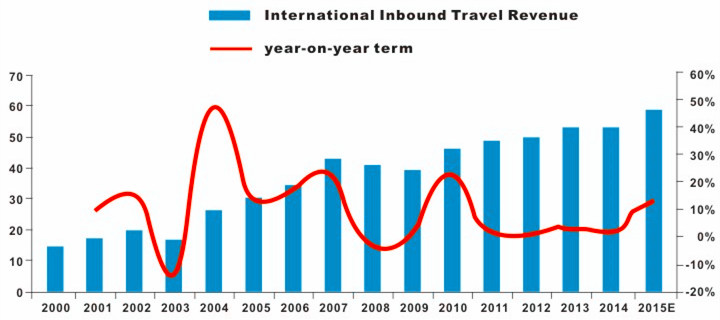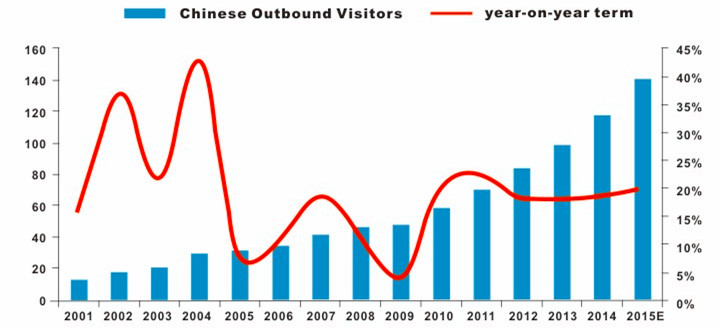
China Tourism
During 2004 to 2014, it was the golden era of Chinese tourism industry. Domestic travel people had increased up to 3.6 billion compare to 744 million in 2004.
As an important element of China's tourist market, the domestic market benefits a lot from the large population. In the recent decades, domestic traveling greatly enhances the employment, consumption and economic development of the country. Currently, the most popular destinations for domestic travelers include Beijing, Shanghai, Guangzhou, Xi'an, Guilin, Hangzhou, Sanya, Lhasa, Chengdu, Lijiang, Hong Kong, and Macau. The visitor quantity soars to amazing numbers during the peak seasons, especially the two golden weeks (the National Day Holiday, from Oct. 1 to 7 and the Chinese New Year). This may cause traffic problems and poor tourist service quality. When planning a visit to China, you should avoid these rush periods.
At present, domestic tourism is still the main force of driving china’s tourism industry growth. In 2015, domestic travel customers had increased up to 4 billion Chinese yuan, which was around 603 million US dollars (according to the exchange rate during November, 2017), becoming the largest domestic tourism market on the global level.
Inbound Tourim In China
According to the professional survey from Chinese tourism industry, the total international inbound travelers to China in 2015 has gone up to 133.82 million people with an increase of 4.14% on a year-on-year basis. Among them, the real foreigner number was 25.99 million, with a slightly decrease of 1.4% compared to last year; the Hong Kong, Macao and Taiwanese Chinese to china mainland inbound tourists were up to 107.83 million people with a notable increase of 5.6% compared to last year. On overall level of speech, the total revenue of inbound international travel business in 2015 was 113.7 billion US dollars with a notable increase of 7.8% on a year-on-year basis.
If we zoom in and give a close view of how exactly the total revenue had been contributed by each type of those inbound travellers, the detailed statistics are: foreigners and Hong Kong Chinese have together made a contribution of 80.98% to the total inbound travel business revenue, Taiwan Chinese has made a contribution of 12.45% and Macao Chinese has made a contribution of 6.6%.
2001-2015 China International Inbound Travel Revenue in USD

Of all the international inbound travellers, visitors come china for leisure accounts up to 31% occupying as the top issue; Visitors come for a business trip accounts up to 21%; visitors come china for relatives visiting accounts to 3%.
If we analysis the statistics in the aspect of expenditure of all international inbound tourists in china, 70% travelers’ total expenditure in their China trip are between 500-3000 USD with the transportation cost making the most costly section in their China trips. Unlike Chinese travelers aboard whose luxury goods shopping expenditure making the most costly section in their travel bills, foreigners come to china are more keen on scenic and culture site-seeing. From 1th July, 2016, Beijing has released the departure tax refund policy to encourage tourists to purchase more valuable goods or souvenirs during their china trips.
| 1. Hong Kong | 2. Shanghai | 3. Beijing | 4. Macau | 5. Guangzhou |
| 6. Shenzhen | 7. Sanya | 8. Xi'an | 9. Hangzhou | 10. Chengdu |
| 11. Zhangjiajie | 12. Dalian | 13. Xiamen | 14. Zhuhai | 15. Nanjing |
| 16. Guilin | 17. Suzhou | 18. Chongqing | 19. Tianjin | 20. Haikou |
China has carried out various measures to increase the inbound tourism. At present, the 72-hour visa-free transit policy has been adopted in more and more cities to welcome more overseas guests. The convenient flight network and the operation of many high speed trains in recent years make traveling in China faster and smoother. Besides, extensive campaigns are held to fight against environmental problems and ensure food safety. It's believed that more advantageous steps will be taken in the near future.
Outbound Tourism In China
Thanks to the great improvement in Chinese people's living standards and consumption level, the outbound visitors grows by leaps and bounds. Chinese people are now eager to go outside to explore other parts of the world, which creates a tremendous market for foreign countries. The hottest destinations include South Korea, Japan, Thailand, France, Italy, Switzerland, Germany, USA, Singapore and Maldives, some of which are nearby Asian countries. Based on the huge population, a further and sustained growth of outbound visitors is expected.
In the aspect of outbound tourism business, China now has become the most fast-growing and biggest outbound travel producing country in the world. In 2015, the total Chinese outbound traveller number has gone up to 120 million. This is mainly because recently years under the open and reform policy of china government, the wealth level of Chinese people has been lifted a lot. 60% of outbound Chinese travellers travel overseas for leisure and 20% for adventure.
2001-2015 Chinese Outbound Visitors in Million

By 2015, the top ten outbound destinations of Chinese oversea travellers are Korea, Taiwan, Japan, Hong Kong, Thailand, France, Italy, Switzerland, Macao and Germany. Among them, Japan, Korea, Thailand has attracted nearly 70% of all the outbound travellers of China.
However, the travel and tourism industry is one of china’s well-performing industries with a total economic contribution (direct, indirect and induced) of over 120 billion U.S. dollars in 2016, accounting up to more than 10% of GDP, according to China National Tourism Administration. According to the report of tourism suggestion from state council in August 2014, by 2020 China tourism industry would have the estimated revenue of 5.5 trillion Chinese yuan.
There are 1349 international travel agencies existing in China, they are in tourism cities of each province. And 248 of them are inthe four municipalities- Beijing, Shanghai, Tianjin and Chongqing. The direct employee within tourism industry in Chinese is 24.98 million and the indirect jobs provided by tourism industry is much higher number with a total account of 79.11 million people. The total population that involved in Chinese tourism industry accounts up to 10.2% of the whole Chinese population. (The statistics in this paragraph are all up to 2015).
The World Tourism Organization predicts that China will become the largest travel destination and the fourth largest source country by 2020. In that year, there will be 137.10 million international travelers to the country, taking up 8.6% of the global share, and 100 million outbound Chinese visitors, 6.2% of the worldwide outbound visitors.







 Ask Questions ?
Ask Questions ?